Traces of Simon in Trent
The cult of Simon of Trent emerged soon after the boy’s body was found, even before the trial was in full swing. But the cult was not recognized by the pope until the 1580s. Its recognition led to a creation of a local pilgrimage route, its traces still visible today. For a full discussion of this process, including the topography in Trent, see Chapter Three of Blood Libel: On The Trail of An Antisemitic Myth.

Doors to St. Peter’s Church, Trent. Simon of Trent in Glory, bottom right. 
Doors to St. Peter’s Church, Trent. Simon of Trent in Glory, bottom right. 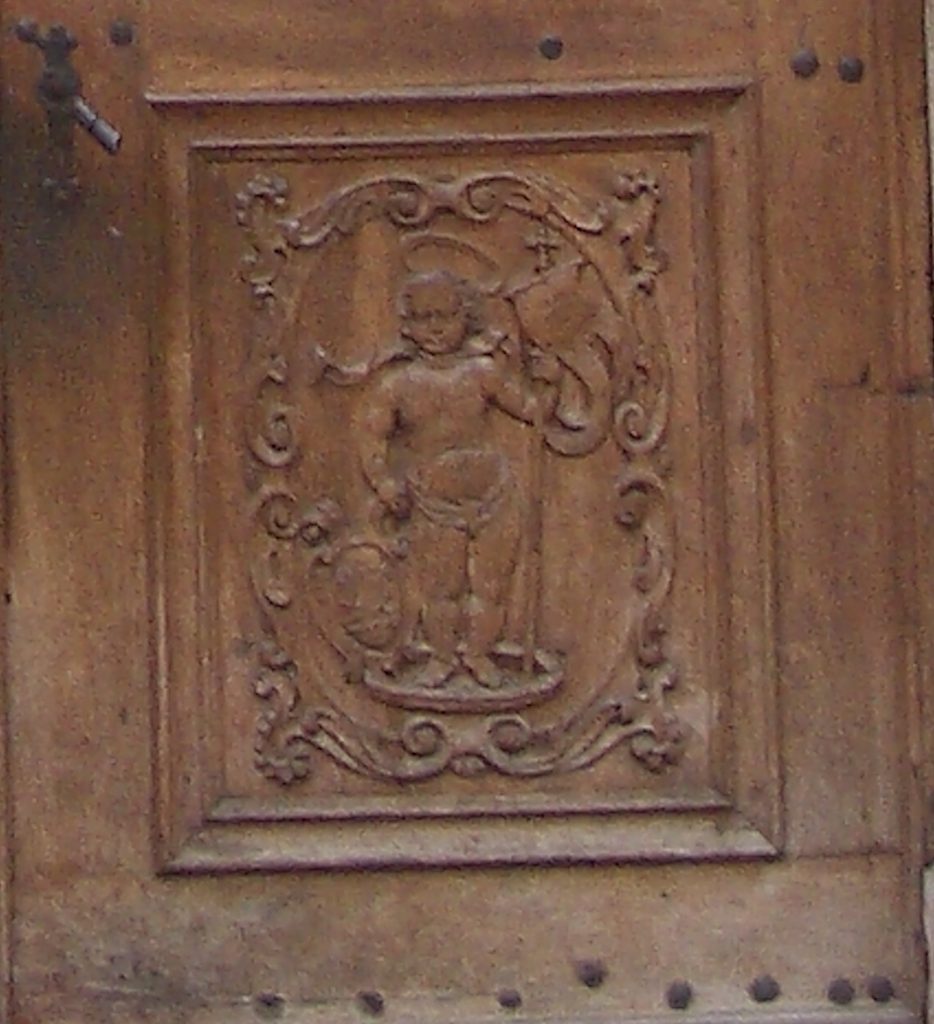
St. Peter’s Church, Trent. Simon of Trent in Glory, bottom right detail 
Palazzo Salvadori, Trent, built at the beginning of the 16th century in place of Samuel’s house, which had the small Trent synagogue in 1475. 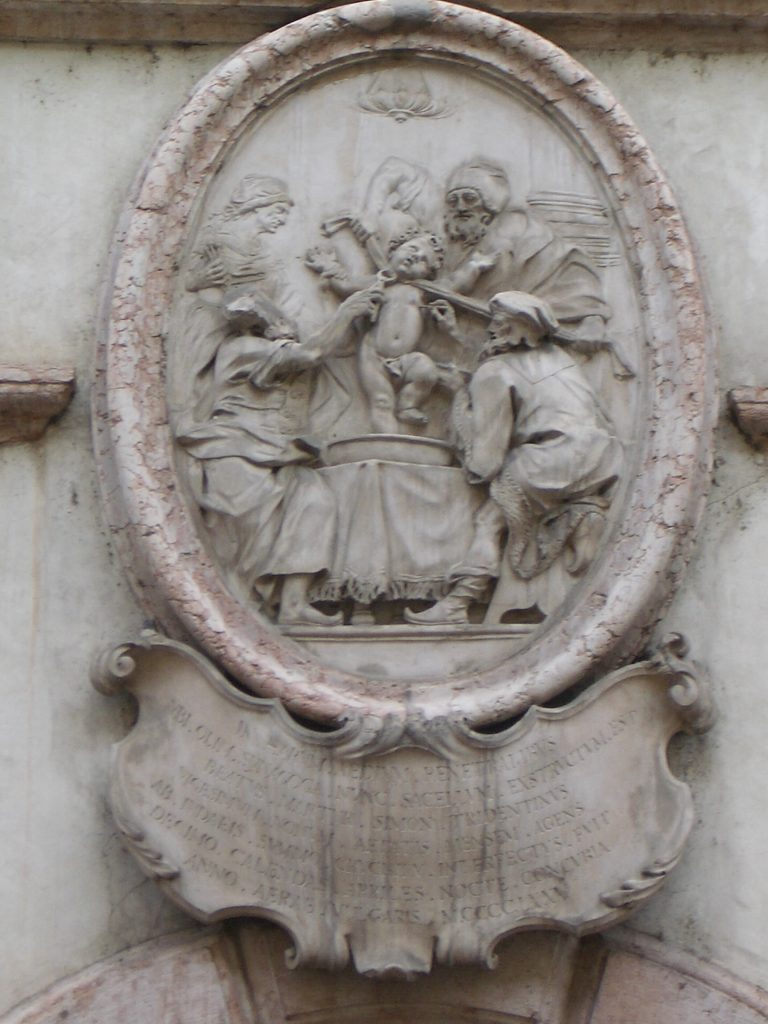
Palazzo Salvadori, Trent, 18th-century relief depicting “Simon’s martyrdom” 
Palazzo Salvadori, Trent. 18th-century relief of “Simon in glory” 
Fossato Simonino, now via Simonino. Historic postcard 
Casa Simonino, Simon’s house. 1910 postcard. 
Casa Simonino, Trent. Simon’s house, with a fresco and sculpture of Simon in Glory, 2007.
The earliest iconographic representations of Simon’s story (September 6, 1475)
The earliest representations not just of Simon but of Jews in print come from Trent and the aftermath of the trial. The images below come from Albert Kunne’s Hystorie von Simon zu Trient published on September 6th, 1475, just three days after the arrival of the papal envoy Bishop de Giudici of Ventimiglia who was sent to Trent from Rome to investigate the verity of the accusations against Jews and the validity of the cult. More on this see Chapter Two.

Jews conspiring to kidnap a child, with Christian symbols of fish and lamb, Hystorie von Simon zu Trient (Trent: Albert Kunne, September 6, 1475), 1v. Bayerische StaatsBibliothek, 2 Inc.s.a. 62#Beibd. https://opacplus.bsb-muenchen.de/title/BV023373593 
Tobias capturing Simon, Hystorie von Simon zu Trient (Trent: Albert Kunne, September 6, 1475), fol. 2v. Bayerische StaatsBibliothek, 2 Inc.s.a. 62#Beibd. https://opacplus.bsb-muenchen.de/title/BV023373593 
Hystorie von Simon zu Trient (Trent: Albert Kunne, September 6, 1475), fol. 3v. Type “martirio.” Bayerische StaatsBibliothek, 2 Inc.s.a. 62#Beibd. https://opacplus.bsb-muenchen.de/title/BV023373593 
Simon as martyr, Hystorie von Simon zu Trient (Trent: Albert Kunne, September 6, 1475), fol. 4v. Bayerische StaatsBibliothek, 2 Inc.s.a. 62#Beibd. https://opacplus.bsb-muenchen.de/title/BV023373593 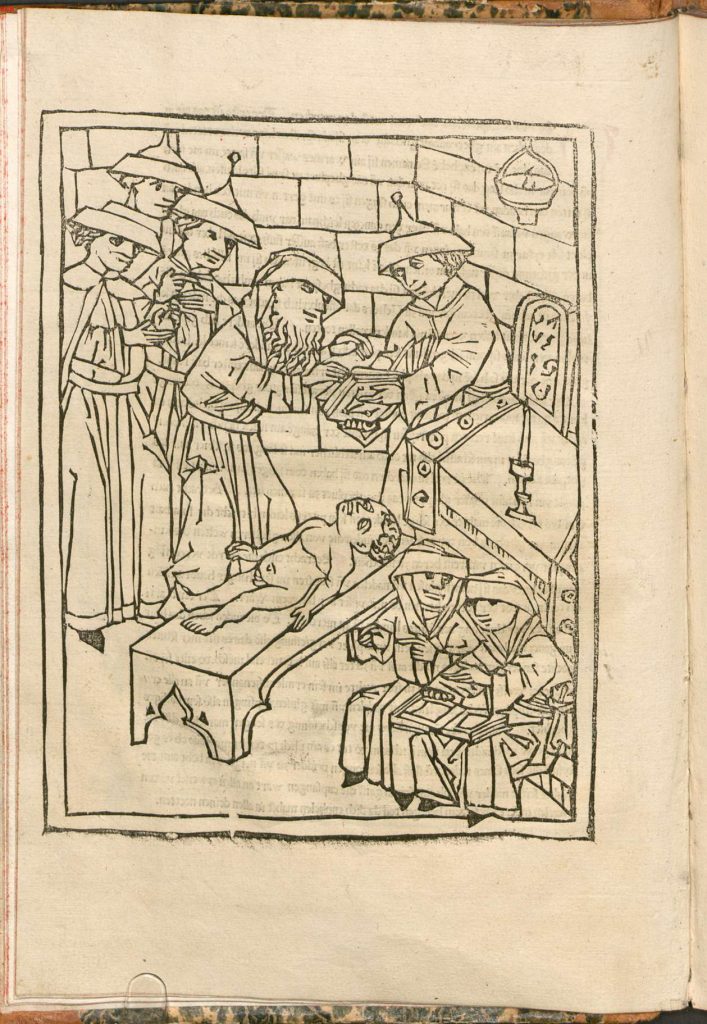
Simon’s corpse (“victima”), Hystorie von Simon zu Trient (Trent: Albert Kunne, September 6, 1475), fol. 5v. Bayerische StaatsBibliothek, 2 Inc.s.a. 62#Beibd. https://opacplus.bsb-muenchen.de/title/BV023373593 
Passover seder, Hystorie von Simon zu Trient (Trent: Albert Kunne, September 6, 1475), 6v. Bayerische StaatsBibliothek, 2 Inc.s.a. 62#Beibd. https://opacplus.bsb-muenchen.de/title/BV023373593 
Discovery of Simon’s body, Hystorie von Simon zu Trient (Trent: Albert Kunne, September 6, 1475), fol. 7v. Bayerische StaatsBibliothek, 2 Inc.s.a. 62#Beibd. https://opacplus.bsb-muenchen.de/title/BV023373593 
Examination of Simon’s body after its discovery, Hystorie von Simon zu Trient (Trent: Albert Kunne, September 6, 1475), 8v. Bayerische StaatsBibliothek, 2 Inc.s.a. 62#Beibd. https://opacplus.bsb-muenchen.de/title/BV023373593 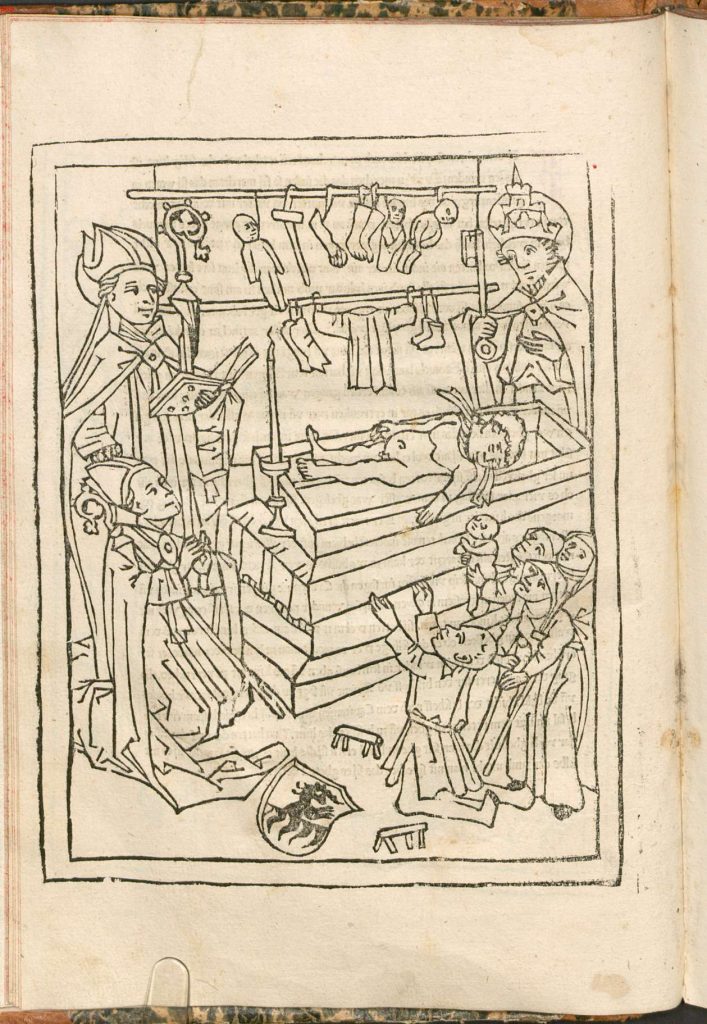
Simon on the altar (“victima”), Hystorie von Simon zu Trient (Trent: Albert Kunne, September 6, 1475), fol. 9v. Bayerische StaatsBibliothek, 2 Inc.s.a. 62#Beibd. https://opacplus.bsb-muenchen.de/title/BV023373593 
Execution of Jews, Hystorie von Simon zu Trient (Trent: Albert Kunne, September 6, 1475), 10v. Bayerische StaatsBibliothek, 2 Inc.s.a. 62#Beibd. https://opacplus.bsb-muenchen.de/title/BV023373593 
Jews put to the flames, Hystorie von Simon zu Trient (Trent: Albert Kunne, September 6, 1475), 11v. Bayerische StaatsBibliothek, 2 Inc.s.a. 62#Beibd. https://opacplus.bsb-muenchen.de/title/BV023373593 
Execution of the baptized Jews, Hystorie von Simon zu Trient (Trent: Albert Kunne, September 6, 1475), 12v. Bayerische StaatsBibliothek, 2 Inc.s.a. 62#Beibd. https://opacplus.bsb-muenchen.de/title/BV023373593
Simonine iconography by type -“Martyrio”(killing)
During the Trent trial and soon after, three types of iconography developed: martyrio, depicting the alleged killing of Simon; victima, Simon’s lifeless body; and Simon “in glory.” With time, there would be a distinct geographic distribution of these types: “in glory” dominating the Italian iconography, and “martyrio” the northern European. The image from Schedel’s 1493 Liber chronicarum became the iconic image of “blood libel” or “ritual murder.” There is no evidence that this image had much cultural significance in the early modern period. It became “iconic” thanks to its ubiquitous use by the Nazis, especially the May 1, 1934 issue of Der Stürmer. Far more replicated was the image reproduced in Gottfried’s and Gueudeville’s chronicles.

Hystorie von Simon zu Trient (Trent: Albert Kunne, September 6, 1475), fol. 3v. Type “martirio.” Bayerische StaatsBibliothek, 2 Inc.s.a. 62#Beibd. https://opacplus.bsb-muenchen.de/title/BV023373593 
Simon as martyr, Hystorie von Simon zu Trient (Trent: Albert Kunne, September 6, 1475), fol. 4v. Bayerische StaatsBibliothek, 2 Inc.s.a. 62#Beibd. https://opacplus.bsb-muenchen.de/title/BV023373593 
Broadsheet bound with Johannes Matthias Tiberinus, Passio Beati Simonis pueri Tridentini a p[er]fidis judeis nup[er] occisi. Rome: Bartholomaeus Guldinbeck, 1475 at the Bayerische StaatsBibliothek, Rar. 337. Brunetta is named “Pruneta.” https://opacplus.bsb-muenchen.de/title/BV023383840 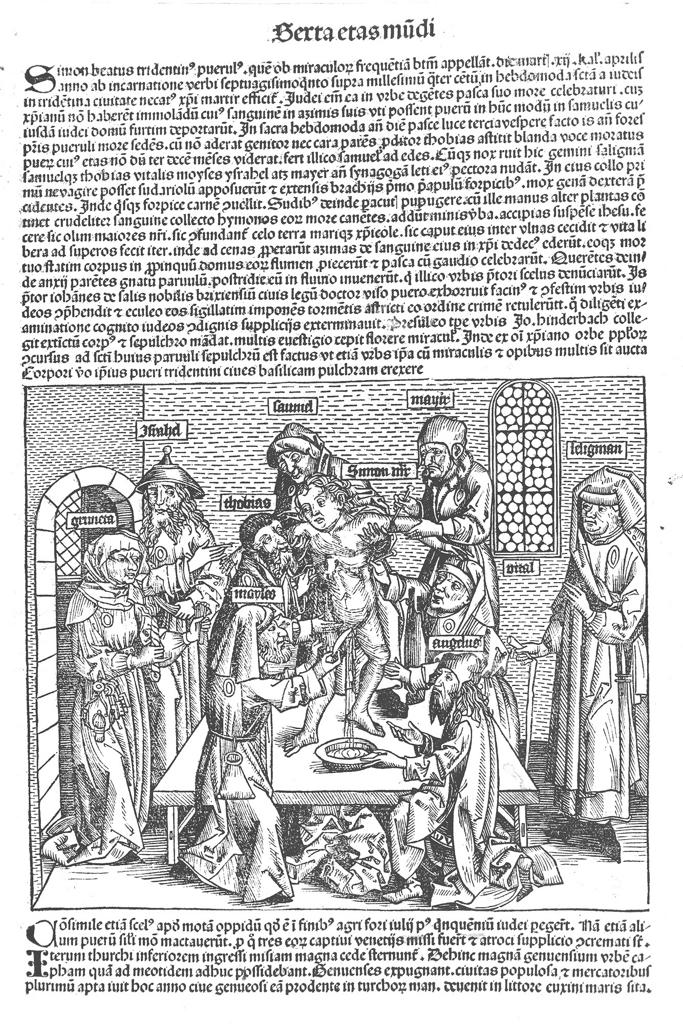
Simon of Trent, Hartmann Schedel, Liber chronic arum (Nuremberg: Anton Koberger, 1493), CCLIIII verso. 
Simon of Trent in the pirated edition of Hartmann Schedel, Liber chronicarum cum figuris et imaginis ab initio mundi usque nunc temporis (Augsburg: Johann Schönsperger, 1497), 285v. 
Palazzo Salvadori, Trent, 18th-century relief depicting “Simon’s martyrdom” 
Simon of Trent in Johann Ludwig Gottfried, Historische chronica; oder, Beschreibung der fürnehmsten geschichten so sich von Anfang der Welt biss auff das jahr Christi 1619 (Frankfurt am Main: Merian, 1674), p. 689. 
Simon of Trent in Gottfried, Johann Ludwig. Omstandigh Vervolgh Op Joh. Lodew. Gottfrieds Historische Kronyck (Leiden, 1698), p. 1408 
Simon of Trent in Nicolas Gueudeville, Le Grand Theatre Historique (Leiden, 1704), vol. 4, 206. © http://diglib.hab.de/drucke/gb-2f-11-2b-2s/start.htm?image=00107 licensed for digital commons.
Simonine iconography by type -“Victima” (corpse)

Examination of Simon’s body after its discovery, Hystorie von Simon zu Trient (Trent: Albert Kunne, September 6, 1475), 8v. Bayerische StaatsBibliothek, 2 Inc.s.a. 62#Beibd. https://opacplus.bsb-muenchen.de/title/BV023373593 
Simon on the altar (“victima”), Hystorie von Simon zu Trient (Trent: Albert Kunne, September 6, 1475), fol. 9v. Bayerische StaatsBibliothek, 2 Inc.s.a. 62#Beibd. https://opacplus.bsb-muenchen.de/title/BV023373593 
1475, German broadsheet showing pilgrims visiting the relics of Simon, in a position known as victima. Bound with the account of Matthia Tiberino. Bayerische StaatsBibliothek, Rar. 338. https://opacplus.bsb-muenchen.de/title/BV023383597 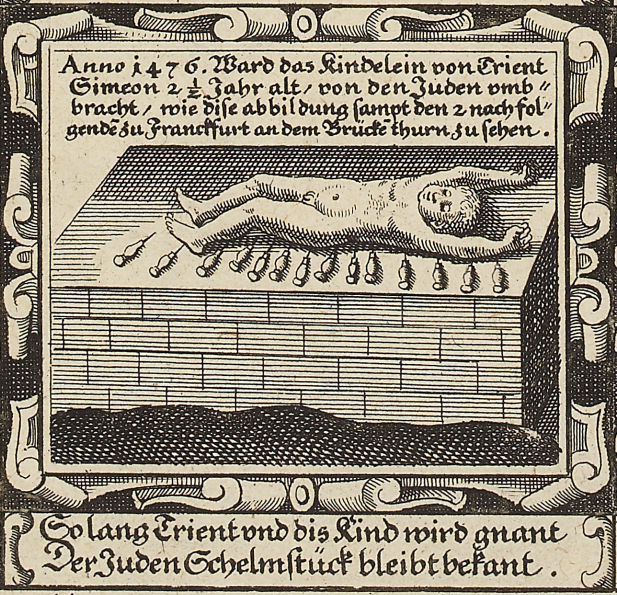
A mural of Simon of Trent in its Brückenturm as represented in Der Juden Badstub broadside, ca. 1615. ©The Trustees of the British Museum. All rights reserved. https://www.bmimages.com/preview.asp?image=01000036001
Simonine iconography by type -“in glory”

Antonio Gesti, Martirio di S. Simone di Trento nel quale si tratta de la gran crudeltà che usarono gli empi ebrei in martirizarlo, et come è stato posto nel cattalogo de santi e la solenne processione fatta nella sua prima festa con molti miracoli fatti da esso santo (Trento: Per i fratelli de Gelmini, 1589). Bayerische StaatsBibliothek, V.ss. 839. https://opacplus.bsb-muenchen.de/title/BV001491005 
Simon of Trent, undated late–sixteenth-century painting by a northern Italian painter, painted soon after Simon was included in Martyrologium Romanum, likely between 1583 and 1597. The boy has a halo, the sign of a saint, instead of rays typical of previous representations of Simon as beatus. Private collection. 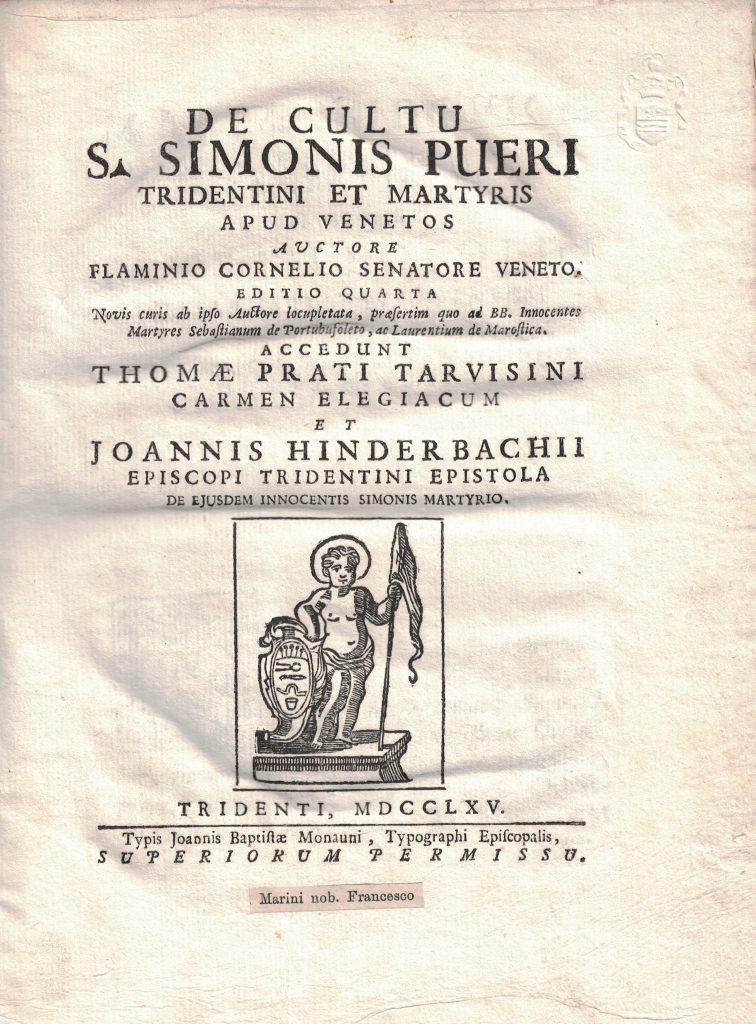
Cornaro, Flaminio. De Cultu S. Simonis Pueri Tridentini et Martyris Apud Venetos. Editio quarta. Tridenti: Typis Joannis Baptistae Monauni, typographi episcopalis, superiorum permissu, 1765. Typology: “Simonino in gloria.” 
Michelangelo Mariani, Il glorioso infante S. Simone: historia panegirica (Trent: Zanetti Stampator Episcopale, 1668). Bayerische StaatsBibliothek, V.ss. 844. https://opacplus.bsb-muenchen.de/title/BV001536392 
Casa del Simonino, Trent. Site of Simon’s house, with a fresco and sculpture of Simon in Glory. 
Casa Simonino, 1910 postcard. Typology “in glory.” 
Palazzo Salvadori, Trent. 18th-century relief of “Simon in glory” 
Devotional card. Simon of Trent, early 20th century. Typology: “in glory.”
Simonine iconography in Andreas von Rinn “in glory”

Der Judenstein: oder Geschichte des Martertodes des unschuldigen Kindes Andreas von Rinn (Innsbruck: Rauch, 1826), frontispiece engraving by Gotthard Uhrschall. Typology: “in glory.” 
Devotional card, Andreas von Rinn, early 20th century. Typology: “in glory.” 
Andreas of Rinn, an early-twentieth-century devotional card. The inscription in the middle reads “The holy Andreas of Rinn in Judenstein.”
